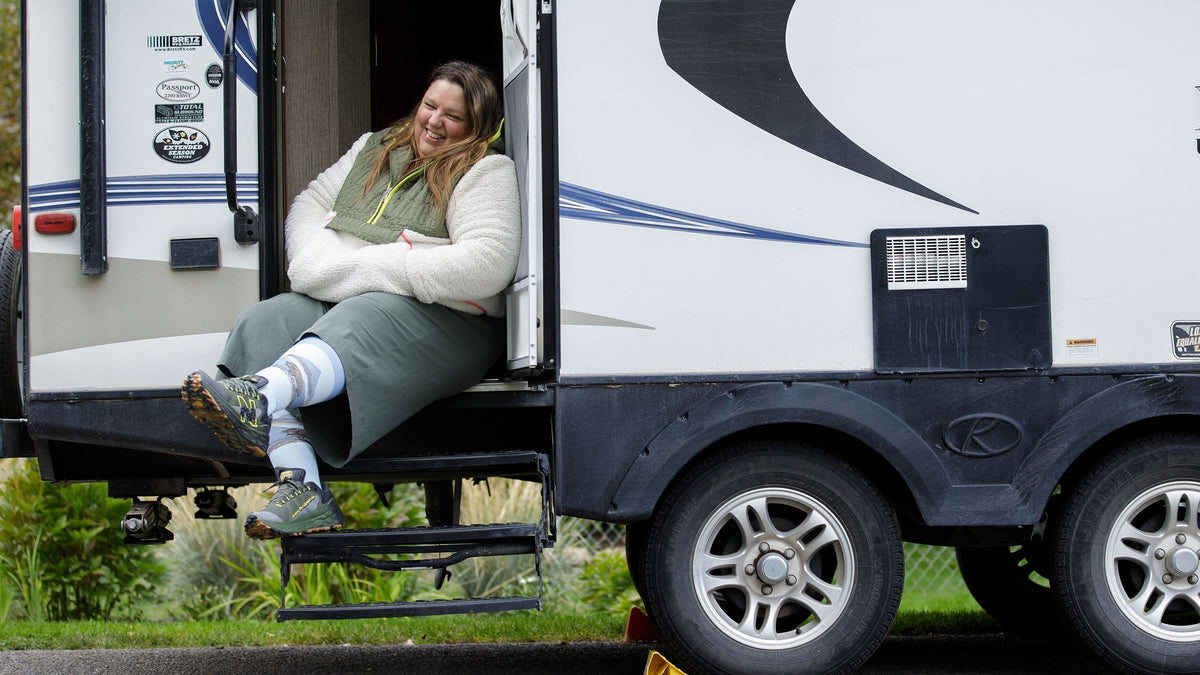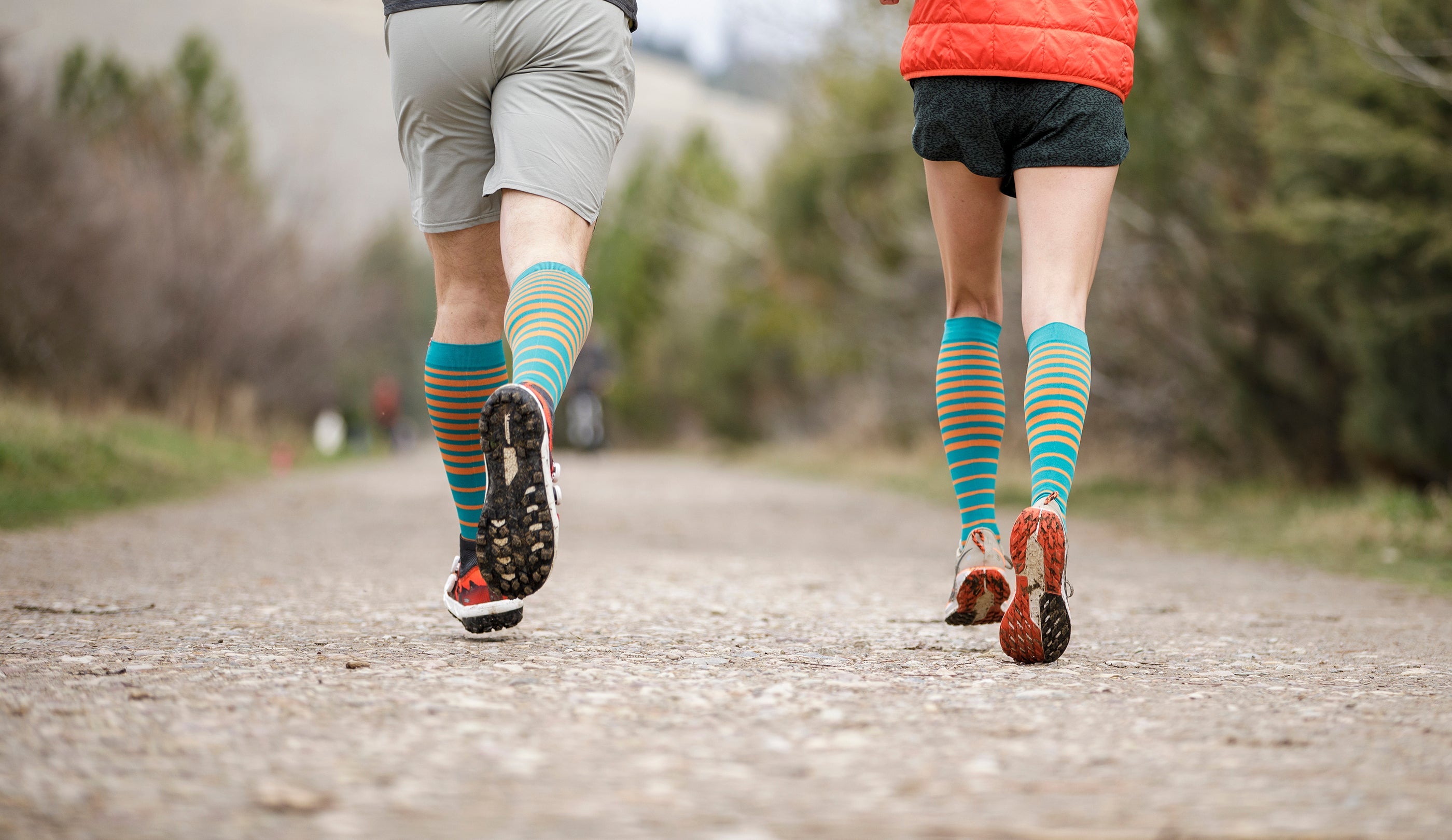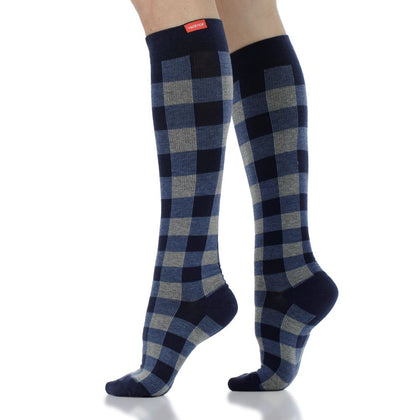


Ready to step up your workday comfort? Explore our best-selling compression socks designed for tough job sites.
The Best Socks for Construction Workers
Graduated compression socks are great for construction workers, as they support the lower leg veins and muscles, boosting peripheral circulation and reducing fatigue, soreness, and swelling. However, not all compression socks are the same. To get the benefits of compression socks, you need to know what to look for. Here’s how to choose the best work socks for your construction shift, so you can be comfortable and pain-free throughout your shift.
Merino Wool Compression Socks for Winter
Merino wool keeps feet cool and ventilated in the summer, but also warm and dry in winter. It’s also great for sensitive skin since merino fibers are hypoallergenic and antibacterial. Besides, merino wool is very durable, making it a long-lasting choice that you can keep wearing for many years.
Additionally, merino wool compression socks are highly breathable and moisture-wicking. On a construction site, you’ll need breathable socks all year round, regardless of whether you work indoors or outdoors. Of course, this becomes even more important in indoor environments or in hot weather.
One extra benefit of merino wool compression socks is that they let feet breathe well even in more constricted footwear, such as work boots. Additionally, the antibacterial qualities of the fabric should help avoid any foot infections or discomfort from spending long hours in closed boots.
Moisture-Wicking Nylon Compression Socks for Summer
Nylon is another great choice for compression socks for construction workers. These socks are thinner and sleeker, moving seamlessly with your body. Vim & Vigr moisture-wicking nylon compression socks are designed specifically to keep feet dry in warm conditions, so they will be a good choice if you tend to feel the heat in work boots. However, some may find them a little thin, so we suggest trying them at home first to ensure they are not leaving too much room in the boots (thus increasing the risk of blisters or discomfort).
Cotton Compression Socks for Daily Wear
At Vim & Vigr, we know how comfortable cotton is for daily wear. It is a versatile fabric that allows us to create imaginative designs and color schemes, and it pretty much matches any outfit. Cotton compression socks can be great for your recovery after a shift and to wear on a regular day out. However, when it comes to construction work and especially hot weather, it doesn’t wick away moisture as well. We recommend Vim & Vigr cotton compression socks for your days off for that reason.
Why Construction Workers Need Compression Socks
Compression socks are known to improve peripheral circulation, supporting healthy blood flow throughout the body. They also reduce the likelihood of blood clots, edema (aka swelling), pain or discomfort (especially if you have blood flow issues), and that “heavy” feeling in the legs. Thanks to the gentle massage they provide to the muscles, they help reduce fatigue and boost muscle recovery, while supporting the ligaments and joints during construction work.
Improved Circulation and Blood Flow
As they apply pressure to the lower legs and are tighter at the ankles, releasing the pressure gradually towards the knee, graduated compression socks are the perfect tool to “fight gravity” and boost peripheral circulation. Instead of having blood pooling at the ankles when you wear normal socks, compression socks stimulate blood flow out of the legs and towards the heart, which helps you have healthy blood flow in the body.
By wearing compression socks, construction and office workers alike can avoid the formation of blood clots and heavy, swollen legs. For any line of work where you’re either sitting or standing for long periods of time, there is the added risk of circulatory problems like varicose veins or deep vein thrombosis. Stimulating continued, healthy circulation reduces these risks.
Reduced Foot and Leg Swelling and Fatigue
Swelling in the lower legs is often caused by fluid retention, such as blood pooling around the ankles. By promoting healthy peripheral blood flow and lymph drainage, compression socks reduce the risk of swelling in the first place. Moreover, wearing them while your legs are swollen might provide other benefits – by massaging the affected area and bringing down inflammation.
Fatigue is often caused by the swelling from standing on your feet all day, as well as by overuse of the lower leg muscles. Since compression socks help take some of the pressure off your muscles, supporting the joints and massaging muscles to energize them, they also help avoid fatigue from settling in (or reduce its impact).
Muscle Support and Lower Risk of Injury
Compression socks grip the lower legs tightly, giving users a feeling of added support instantaneously. This is why they are favored by athletes returning to sport after an injury like Achilles tendonitis - giving them reassurance and extra ankle stability. In construction, there are so many opportunities for a leg injury, simply by spraining an ankle or through overuse. Wearing compression socks adds support to the joints and protects the muscles from repeated strain of micro-vibrations from landing on hard concrete.
Additionally, construction workers are at risk of developing occupational edema - swelling of the lower limbs caused by standing upright for long periods of time. Studies show that compression garments - sock in particular - are effective at reducing this risk.
Faster Recovery After Long Hours On-Site
Finally, a key benefit of wearing compression socks for construction is that they have been shown to reduce the time it takes to recover after effort. Athletes regularly wear them to boost blood flow to the lower leg muscles. This helps the muscles get oxygen and nutrients more quickly, essential for repair and recovery, while also preventing swelling.
After long hours on a construction site, relaxing with compression socks will massage the limbs, which can reduce swelling and inflammation as well as deliver nutrients to your lower leg muscles. This can lead to quicker recovery, help you feel more energized the following day, and prevent long-term soreness.

Browse our hard working compression socks and find the perfect pair to power you through every shift.
How to Wear Compression Socks for Construction Work
Whether you choose to wear compression socks on the construction site or afterwards as a recovery tool, you can benefit from the boost in blood flow and muscle massage throughout the day.
Wearing Compression Socks with Work Boots
Compression socks pair well with work boots as they are knee-high and tight on the legs. Since most boots include ankle protection and ride higher up the leg, regular socks can roll down and become uncomfortable during the workday. Knee-high compression socks remove this issue, all while boosting peripheral circulation and keeping your feet warm and comfortable.
You should always ensure that you’re wearing the right sock size, so they don’t feel too tight and cut off your circulation. If they are too loose, they will also bunch up or roll down in the boots.
When and How Long to Wear Compression Socks
If it’s your first time experiencing compression wear, it’s a good idea to start by keeping your socks on for a couple of hours at a time. This is to get you used to the feeling of pressure on your limbs. So, wear your socks at home, as you relax and recover after work.
Then, you can gradually extend the length of time you spend in your compression socks, up to the point where you are comfortable wearing them for a full work shift. If you wear your socks for the whole time you’re at work, you’ll get a dual benefit: preventing swelling, injuries, and discomfort, but also supporting your legs and reducing fatigue.
There’s no time limit to how long you should wear compression socks - it’s a matter of personal preference. We recommend that you listen to your body, adapt as you go along, and enjoy the benefits!
Maintaining and Cleaning Your Compression Socks
One important aspect of using compression is caring for your socks so that they keep their flexibility and the pressure they apply to your legs. This means washing them after every wear, especially if you’ve had them on for the whole day. Wash your socks with regular detergent on a gentle cycle, or you can even wash them by hand.
Compression socks need to be left to dry naturally, as the dryer can affect the fibers and reduce their effectiveness. This is why you should have a few pairs on rotation if you start wearing them every day.
Additionally, take extra care when you put on and remove your socks. Don’t pull on the material; instead, follow our step-by-step guide to putting them on to maintain them in top shape. Avoid wearing jewellery or putting lotion on your legs or hands before you put on compression socks. You can wear gloves to protect your socks from catching if you have longer nails.
Choosing the Best Compression Socks for Construction Workers
To pick the best pair of compression socks for your construction shifts, you’ll need to consider the material (particularly as you’ll need breathable, moisture-wicking fabrics) and the sizing.
Key Features to Look For
When you pick work compression socks, you need to keep in mind both functionality and comfort. Graduated compression helps boost your peripheral circulation while supporting the lower leg muscles and joints and reducing some of the impact from walking and standing all day. To ensure you can get all these benefits and more, here’s what you should check:
Fabric. The best way to know what you should wear on your construction shift is to try the different compression sock fabrics. Merino wool and moisture-wicking nylon are the best choices for hot and/or humid conditions, but you may prefer cotton depending on the length of your shifts and the weather. There are pros and cons for each type of fabric - you can learn more here.
Design and seams. Another key element for your comfort is whether the seams and overall design of your socks prevent rubbing and blisters. Vim & Vigr nylon socks also come in a seamless design, specifically to avoid any discomfort and hot spots.
Compression levels. Not all compression socks are equally tight. Typically, 15-20 mmHg is the casual, everyday wear level of compression that most people will benefit from. But you may need tighter socks if you have a medical condition or circulatory problems. We go into more detail below.
Choosing the Right Compression Level
Compression levels measure just how tight the grip of your work compression socks will be. While most people don’t need a very high level of therapeutic pressure, this varies with personal preference and medical history.
-
15-20 mmHg compression socks are best for first-time users, casual wearers, and long-term wear. You can comfortably keep them on for an entire workday and get the benefit of muscle support and improved circulation.
-
20-30 mmHg socks are tighter and recommended for those who have a diagnosed circulatory problem. They are used successfully to improve circulation by people who suffer from edema, deep vein thrombosis or varicose veins. Check with your healthcare provider if they could benefit you.
-
30-40 mmHg socks are only available with a doctor’s prescription. They will benefit those with venous insufficiency and lymphedema, among other conditions.
Wide Calf Options and Finding the Best Fit
To ensure you get the benefits of compression, you need to find the best size for you: not too loose, or the socks will roll down your legs; and not too tight, or they’ll be uncomfortable and cut off your circulation. The best way to get the sizing right is to measure your calf circumference and match that against your shoe size in a sizing table.
Once you have your socks, here are some tips to how they should fit for best results:
The toes and heels should be nestled well in the extremities designed for them;
There shouldn’t be any folding or bunching of the material - smooth it out after you’ve put on your socks;
The top line of the sock should be just under your knee, and the sock should cover your calf muscles comfortably.
Finally, what if you have wider calves? Vim & Vigr wide calf compression socks have got you covered! For calf circumferences of over 17 inches, we provide a separate set of sizes to ensure you get the best support for the lower leg muscles without feeling uncomfortable.
Well fitting, comfortable compression socks will feel tight, but they shouldn’t be able to keep you from doing your regular activities. Instead, they should make your legs and feet feel lighter and more energized, helping you face the day with a smile!
–
In addition to wearing the best compression socks for your construction shifts, remember to also pay close attention to your shoes or boots. If you stand or walk for long periods of time, you need appropriate cushioning and arch support. Work boots are designed to provide this, but some may feel too heavy and cumbersome, or may not offer the proper amount of ventilation you need. Try different pairs and wear them with the compression socks you’re planning to put on for your shift. This is how you can ensure they work well together and feel comfortable enough.
Specialists from the Baylor College of Medicine also highlight the importance of self-care for workers who spend their days on their feet. Your back and leg muscles will stiffen over time, so ensure you stretch at the end of the day. Additionally, putting your feet up helps release tension, boost venous return to the heart, and relax you after a long work day. Finally, wearing high-quality compression socks speeds up the recovery process and soothes your aching muscles.

Say goodbye to tired feet — shop our sock collection and experience all-day support that works as hard as you do.
References
Agle, C. G., de Sá, C. K. C., Amorim, D. S., & Figueiredo, M. A. M. (2020). Evaluation of the effectiveness of wearing compression stockings for prevention of occupational edema in hairdressers. Jornal vascular brasileiro, 19, e20190028. Read it here.
Armstrong, S. A., Till, E. S., Maloney, S. R., & Harris, G. A. (2015). Compression socks and functional recovery following marathon running: a randomized controlled trial. Journal of strength and conditioning research, 29(2), 528–533. Read it here.
Charles, T., Mackintosh, D., Healy, B., Perrin, K., Weatherall, M., & Beasley, R. (2011). Merino wool graduated compression stocking increases lower limb venous blood flow: a randomized controlled trial. Advances in therapy, 28(3), 227–237. Read it here.
Guedes, P. M., Saldanha, N. A., Matos, P. M., Carvalho, F. S., Veiga, G., & Norton, P. (2020). Occupational leg edema-use of compression stockings. Porto biomedical journal, 5(6), e093. Read it here.
Ivankovic, T., Rajic, A., Ercegovic Razic, S., Rolland du Roscoat, S., & Skenderi, Z. (2022). Antibacterial Properties of Non-Modified Wool, Determined and Discussed in Relation to ISO 20645:2004 Standard. Molecules (Basel, Switzerland), 27(6), 1876. Read it here.
Lim, C. S., & Davies, A. H. (2014). Graduated compression stockings. CMAJ: Canadian Medical Association journal = journal de l'Association medicale canadienne, 186(10), E391–E398. Read it here.
Mosti, G., Picerni, P., & Partsch, H. (2012). Compression stockings with moderate pressure are able to reduce chronic leg oedema. Phlebology, 27(6), 289–296. Read it here.
Mota, G. R., Simim, M. A. M., Dos Santos, I. A., Sasaki, J. E., & Marocolo, M. (2020). Effects of Wearing Compression Stockings on Exercise Performance and Associated Indicators: A Systematic Review. Open access journal of sports medicine, 11, 29–42. Read it here.
Motykie, G. D., Caprini, J. A., Arcelus, J. I., Reyna, J. J., Overom, E., & Mokhtee, D. (1999). Evaluation of therapeutic compression stockings in the treatment of chronic venous insufficiency. Dermatologic surgery: official publication for American Society for Dermatologic Surgery [et al.], 25(2), 116–120. Read it here.
Partsch, H., Winiger, J., & Lun, B. (2004). Compression stockings reduce occupational leg swelling. Dermatologic surgery: official publication for American Society for Dermatologic Surgery [et al.], 30(5), 737–743. Read it here.
Sachdeva, A., Dalton, M., & Lees, T. (2018). Graduated compression stockings for prevention of deep vein thrombosis. The Cochrane database of systematic reviews, 11(11), CD001484. Read it here.
Shalchi, H. Reviewed by McNeal, M. (2022). Combat the effects of prolonged standing. Baylor College of Medicine. Read it here.











